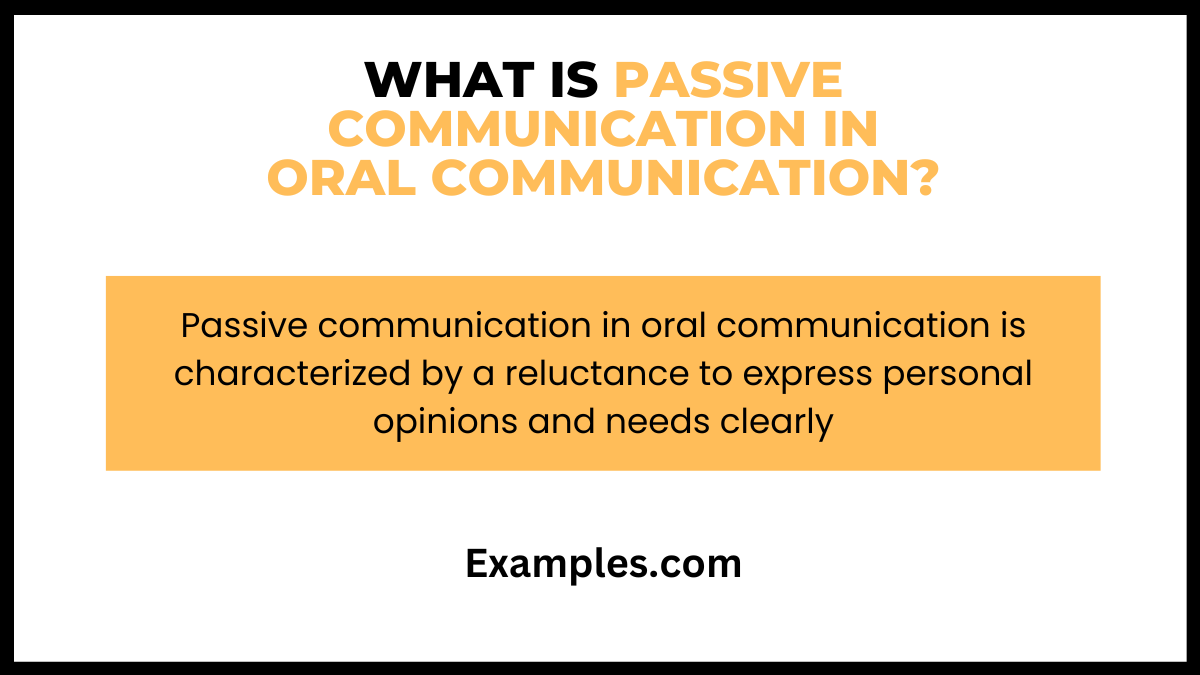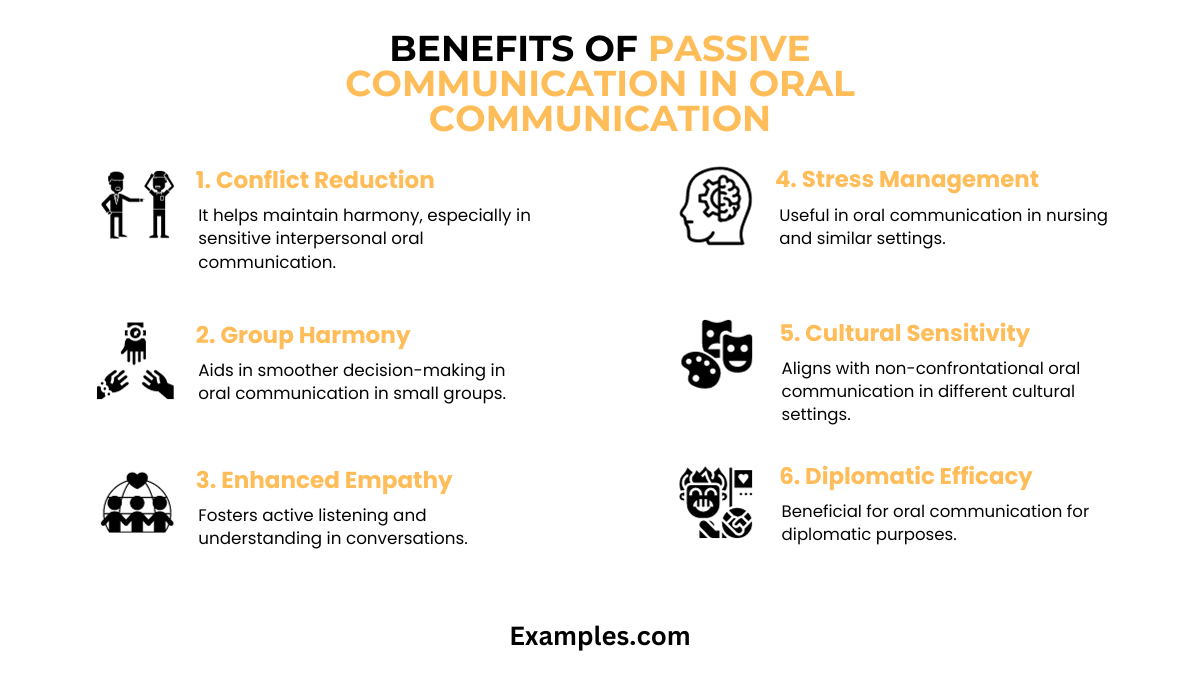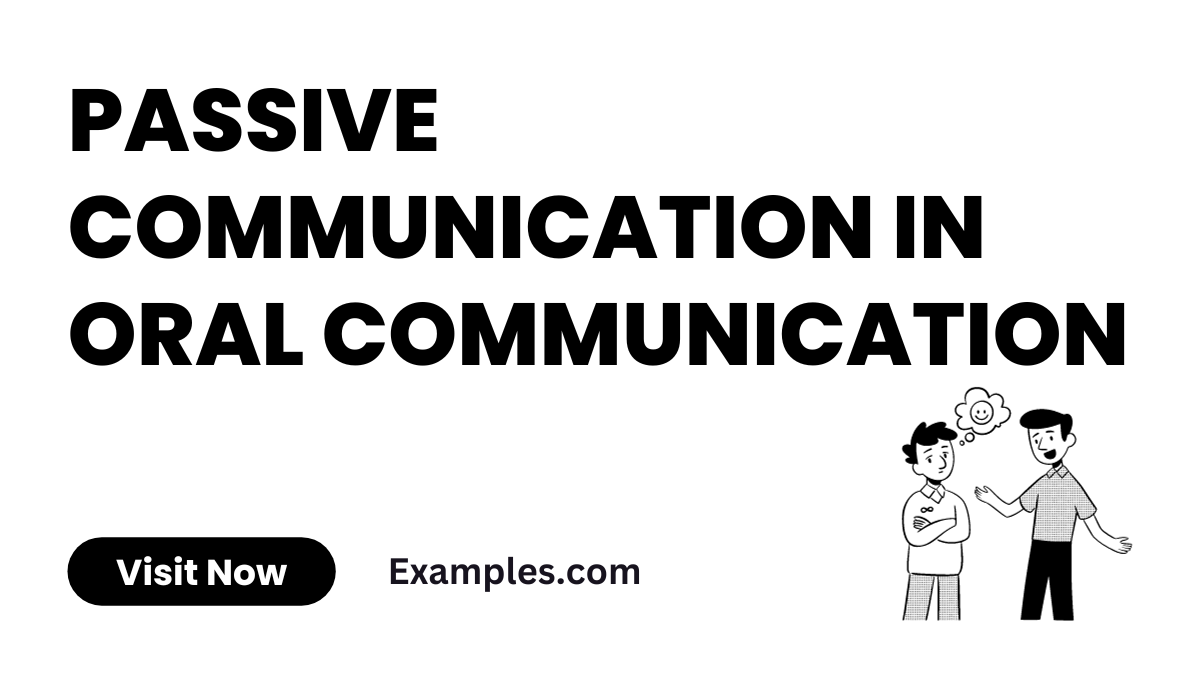Passive communication in Oral Communication
Passive communication in oral communication is a style marked by a notable lack of self-expression and assertiveness. Individuals engaging in this form of communication often hold back their opinions and needs, preferring to yield to others. This approach can lead to misunderstandings and feelings of resentment, as it lacks the clarity and confidence typically seen in more assertive styles. In passive communication, even nonverbal communication cues tend to be subdued, with minimal eye contact and closed body language, which further diminishes the effectiveness of the message conveyed. This communication style, while avoiding conflict, often fails to adequately express the communicator’s true intentions or feelings.
What is Passive Communication in Oral Communication?

Passive communication in oral communication refers to a style where individuals tend to avoid expressing their own opinions or needs, and often yield to others. This communication approach is characterized by a reluctance to speak up or assert oneself, leading to a lack of active listening in Oral Communication and clarity in Oral Communication. People who communicate passively often prioritize others’ needs and opinions over their own, which can lead to misunderstandings and a lack of effective expression. They might use indirect language or nonassertive phrases, lacking the confidence in Oral Communication that assertive communicators display. While passive communicators avoid confrontation, this can often result in their own needs and opinions going unheard, contrasting significantly with assertive or aggressive communication styles.
30 Passive Communication in Oral Communication Examples
Passive communication in oral communication is a reserved and indirect style where individuals often withhold their true thoughts and feelings. This approach, characterized by avoidance of direct expression and confrontation, can lead to misunderstandings and unmet needs. Typically, passive communicators exhibit subdued nonverbal communication cues, like limited eye contact and a lack of assertiveness, which can affect the effectiveness of their interactions. Understanding this style is crucial for recognizing and addressing communication barriers.
- “Whatever you think is best.”
Indicating a lack of opinion, leaving decisions to others. - “I don’t mind, you choose.”
Avoiding making choices, deferring to someone else’s preference. - “Sorry to bother you, but could you help me?”
Apologizing unnecessarily before asking for assistance. - “I guess it’s okay.”
Showing reluctance to express disagreement or dissatisfaction. - “It doesn’t really matter to me.”
Indicating indifference and not voicing personal preferences. - “You’re probably too busy for this.”
Assuming others’ unavailability without direct inquiry.

- “If it’s not too much trouble…”
Prefacing requests with qualifiers to avoid inconvenience. - “I’m not sure, what do you think?”
Seeking others’ opinions while downplaying one’s own. - “Maybe we could try this, but it’s just a thought.”
Suggesting ideas hesitantly, without confidence. - “I can do it, but someone else might be better.”
Undermining one’s own abilities or suitability. - “I suppose I could be wrong.”
Expressing self-doubt and uncertainty in one’s viewpoint. - “I don’t want to trouble anyone.”
Prioritizing others’ convenience over personal needs.

- “It’s just a small issue, nothing important.”
Minimizing one’s concerns or problems. - “I’ll just go along with what everyone else decides.”
Avoiding expressing a unique standpoint. - “That might not be a good idea, but I’m not sure.”
Indirectly expressing disagreement with uncertainty. - “I don’t know, maybe.”
Exhibiting indecision and lack of commitment. - “If you think it’s right, then it must be.”
Deferring judgment to others. - “Sorry, I’m not really an expert.”
Downplaying one’s knowledge or expertise.

- “I wouldn’t want to impose my view.”
Avoiding sharing personal opinions to prevent conflict. - “It’s fine, I can adjust.”
Showing a willingness to adapt, even if inconvenient. - “I don’t really have a preference.”
Expressing neutrality to avoid making a choice. - “It’s okay, I can wait.”
Showing readiness to be sidelined for others. - “You probably know better than I do.”
Deferring to others’ judgment or expertise. - “I’m not one to make waves.”
Indicating a tendency to avoid conflict or confrontation. - “I can work around your schedule.”
Prioritizing others’ convenience over one’s own. - “It’s just a small idea, probably not worth much.”
Presenting one’s ideas as insignificant. - “I don’t want to be a bother.”
Expressing concern about being an inconvenience. - “I’m not really sure, what does everyone else think?”
Seeking group consensus rather than stating a personal opinion. - “I could be wrong, but…”
Introducing an opinion with a disclaimer. - “It’s no big deal, I can manage.”
Playing down personal needs or issues.
What are the Benefits of Passive Communication in Oral Communication?

While passive communication in oral communication is often viewed as less effective than assertive styles, it does have its unique benefits, especially in specific contexts:
- Reduces Conflict: One of the primary benefits of passive communication is its ability to minimize conflict. In situations where maintaining harmony is crucial, passive communication can be useful. By avoiding direct confrontation and expressing opinions in a non-threatening manner, it helps in keeping the peace, particularly in interpersonal oral communication.
- Facilitates Smooth Group Dynamics: Passive communication can sometimes aid in smoother group interactions, especially when the goal is to reach a consensus without causing friction. By not asserting one’s opinions aggressively, it allows for a more democratic process, often seen in oral communication in small groups.
- Encourages Listening and Empathy: Since passive communicators often prioritize listening over speaking, this style can foster a deeper understanding and empathy in conversations. It encourages active listening in Oral Communication, which can be beneficial in understanding the broader context of a discussion.
- Avoids Overwhelming Situations: In high-stress or overwhelming scenarios, passive communication can prevent the situation from escalating. This approach can be particularly effective in environments like oral communication in nursing or oral communication in social work, where sensitivity and patience are paramount.
- Supports Non-Confrontational Cultures: In certain cultural contexts where directness is frowned upon, passive communication aligns well with cultural norms. It respects the cultural nuances of oral communication in different cultural settings, ensuring that communication remains respectful and culturally appropriate.
- Helpful in Certain Professional Contexts: In certain job roles where diplomacy and tact are essential, such as in oral communication for diplomatic purposes, passive communication can be a strategic choice. It helps in navigating sensitive topics without causing offense.
What are the Impacts of Passive Communication in Oral Communication?
Passive communication in oral communication significantly influences both the communicator and the receiver. Understanding these impacts is crucial in various interpersonal and professional contexts:
- Reduced Self-Expression: Passive communicators often struggle to express their true thoughts and feelings, leading to a lack of active listening in Oral Communication. This can result in their ideas and needs being overlooked or ignored.
- Potential Misunderstandings: Due to the indirectness and ambiguity of passive communication, there’s a higher chance of misunderstandings. The lack of clarity in Oral Communication can lead to confusion and inefficiency.
- Relationship Dynamics: Passive communication can create imbalances in relationships, where passive individuals may feel undervalued or unheard. This can affect the quality of both personal and professional relationships.
- Emotional Impact: Regular passive communication can lead to feelings of frustration, resentment, or low self-esteem, as individuals may feel their needs are consistently unmet.
- Workplace Efficiency: In professional settings, passive communication can hinder decision-making processes and teamwork, impacting overall productivity and morale.
Understanding these impacts helps in identifying and addressing the limitations of passive communication, thereby improving overall communication effectiveness.
What are the Styles of Passive Communication in Oral Communication?
Passive communication in oral communication manifests in various styles, each with unique characteristics. Understanding these styles is key to recognizing and effectively responding to them in different contexts:
- Indirect Communication: This style involves hinting or implying one’s needs or thoughts instead of stating them outright, lacking the clarity and active listening typically found in more direct communication forms.
- Submissive Communication: Here, individuals tend to prioritize others’ needs over their own, often agreeing with others to avoid conflict, which contrasts with the assertive style’s confidence in Oral Communication.
- Avoidant Communication: This style is characterized by avoiding conversations or topics that might lead to discomfort or conflict, lacking the direct engagement of active listening in Oral Communication.
- Self-Deprecating Communication: In this style, individuals tend to downplay their abilities or achievements, often deflecting compliments, which lacks the confidence and positive oral communication seen in more assertive styles.
- Over-Apologizing: Frequent and unnecessary apologies, even when not at fault, are common in this style, indicating a lack of confidence that is crucial in effective oral communication.
- Non-Assertive Agreement: Often agreeing with others’ opinions or decisions without voicing one’s own, this style lacks the active participation and assertiveness seen in more engaged communication forms.
Recognizing these styles of passive communication helps in understanding the dynamics of various interactions and in developing strategies to encourage more assertive and effective communication methods.
How to Improve Passive Communication in Oral Communication
Improving passive communication in oral communication is essential for more effective and assertive interactions. Here are key strategies to transform passive communication habits into more assertive ones:
- Develop Self-Awareness: Begin by recognizing your passive communication patterns. Understanding when and why you resort to passivity, such as in situations of active listening in Oral Communication or during feedback in Oral Communication, is the first step towards change.
- Practice Assertive Language: Start using language that is direct and clear. This involves stating your needs and opinions explicitly, enhancing clarity in Oral Communication. Phrases like “I think” or “I feel” can be empowering.
- Enhance Nonverbal Communication Skills: Nonverbal cues like eye contact, facial expressions, and posture significantly impact how your message is received. Adopting confident body language can help reinforce your verbal messages.
- Build Confidence: Work on building your self-confidence. This can be through personal development activities, such as public speaking classes, which can significantly boost your confidence in Oral Communication.
- Set Boundaries: Learn to say no when necessary. Setting healthy boundaries is a crucial part of moving away from passive communication.
- Engage in Active Listening: Active listening in Oral Communication is not just about hearing but also understanding and responding appropriately. This helps in creating a balanced dialogue.
- Seek Feedback and Practice: Ask for feedback on your communication style and practice regularly. Role-playing scenarios can be particularly effective in practicing assertive communication in a safe environment.
- Learn from Assertive Communicators: Observe and learn from people who communicate assertively. Analyze how they phrase their sentences, their tone of voice, and how they handle feedback in Oral Communication.
- Stay Positive: Maintain a positive attitude towards yourself and others. Positive reinforcement can help in gradually shifting away from passive communication styles.
For a deeper understanding of passive communication and its impact, Psychology Today offers valuable insights into the psychological underpinnings of different communication styles. Additionally, exploring resources from Toastmasters International, known for their expertise in public speaking and communication skills development, can provide practical strategies to enhance communication abilities.



